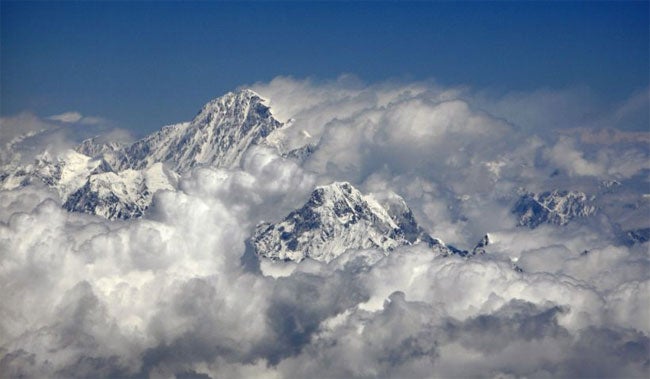Save our blighted Everest, says Hillary's best friend

Sir Edmund Hillary, the "quintessential Kiwi" who conquered Everest, wanted the battle against the ravages of global warming and tourism on the world's highest peak to be his legacy, one of his former climbing companions said yesterday.
George Band, who at 24 was the youngest member of the British-organised expedition on which Hillary and Tenzing Norgay to become the first people to scale Everest on 29 May 1953, said the pioneering mountaineer, who died on Thursday night at the age of 88, was adamant that the fight he had led to preserve the mountain from climate change and damage caused by tourists would continue after his death.
Sir Edmund had become concerned in recent years with the piles of rubbish left by climbing parties on Everest – estimated to weigh as much as 200 tonnes – as well as the risks presented to the native population by vast lakes formed by melting glaciers as a result of climate change.
The New Zealander dedicated much of the five decades after his feat to improving the lives of the Nepalese Sherpas through his charitable trust.
His son, Peter Hillary, said recently that neither Sir Edmund nor Norgay would recognise the mountain they climbed nearly 55 years ago.
Scientists believe Everest, whose Nepalese name Qomolangma means Mother of the World, could be bare rock by 2050 due to glacial retreat.
Mr Band, who is now 78, was among the first to greet the two climbers when they returned to base camp after their ascent. He is now chairman of the Sir Edmund Hillary Himalayan Trust. He said: "Ed [Hillary] saw what he and Tenzing achieved by climbing Everest as the beginning of his work, not the end. He led a life dedicated to public service and much of that was to preserve Everest and help
continued from page three
the people who rely on it for their existence. He was a nice chap who was nonetheless very driven.
"I am sure he would like that work to continue and it will. In many ways we have been successful in helping the Sherpas to improve their lives. He knew that the retreat of the glaciers was happening and presented a new challenge, even though there is nothing that a few people can do to affect climate change in one place. But he saw that what was happening on Everest was a symbol of what is happening in many, many parts of the Himalayas and beyond."
A United Nations report last year warned that up to 40,000 people living under the shadow of the Himalayan peaks are at risk of having their homes swept away after 200 of the 9,000 glacial lakes in the region swelled to dangerous dimensions, presenting a danger of "outburst floods" which unleash millions of cubic metres of water within minutes. The last major outburst flood, more than 20 years ago, destroyed property over a 55-mile radius and the most dangerous lakes today are up to 20 times bigger.
The glacier where Sir Edmund, who downplayed his own climbing prowess and put his skills down to a "strong back", and Norgay pitched their base camp before their assault on the 29,028ft summit has retreated three miles in the past 20 years. The rate of glacial melt accelerated from an average of 40 metres a year in the 40 years to 2001 to 74 metres a year in 2006.
Peter Hillary, 53, who has vowed to continue his father's work, said : "I've seen the result of glacial lakes bursting their banks and it's just catastrophic. It's like an atomic bomb has gone off. Everywhere is rubble. Climate change is happening. This is a fact. Base camp is sinking each year.
"For Sherpas living on Mount Everest this is something they can see every day but they can't do anything about it on their own."
The Himalayan Trust has applauded recent efforts to remove much of the rubbish, including large amounts of empty oxygen bottles, which litter the trail to the summit. But the creeping commercialisation of the pristine mountain which Sir Edmund would have seen continues unabated.
Before his death, Sir Edmund called on people to "leave the mountain alone" and said his most worthwhile achievement was building schools and clinics in the Himalayas: "That has given me more satisfaction than [leaving] a footprint on a mountain."
Some 1,700 people are estimated to have reached the summit since Sir Edmund and Norgay. Growing numbers of people are willing to pay an average of £27,000 to join one of dozens of expeditions each year. At one point last year more than 100 people reached the summit in a single day.
China has announced plans to build an asphalt road to the Everest base camp on the Tibetan side of the mountain to allow the Olympic torch to ascend the world's highest point on its journey to the Beijing Games.
Sir Chris Bonington, who led a famous ascent of the south west face of Everest and is patron of the trust, said: "Ed was a frank and outspoken representative of mountaineers and mountaineering.
"He brought a wonderful fresh air by simply telling situations as they were, for example by raising concern about the number of commercial expeditions. He was fine defender of Everest and he would expect that work to continue."
Join our commenting forum
Join thought-provoking conversations, follow other Independent readers and see their replies
Comments